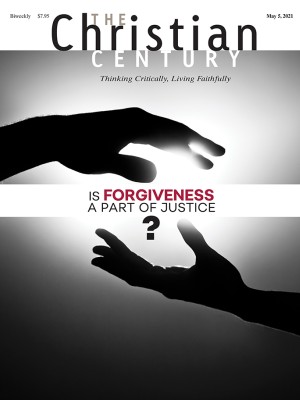May 13, Ascension (Acts 1:1-11; Luke 24:44-53)
What we see reminds us of what we miss, and vice versa.
Tending a church through a global pandemic has been a lesson in the relationship between presence and absence. There was a time when worshipers were present to me only in the form of a camera transmitting our liturgy to the homes of whoever watched that day. They were there, but unknowable and invisible. Video meetings swiftly assumed all the roles of in-person collaboration, with the various kinds of distracted half-absence we’ve learned to notice instantly. Then, as we moved some events and services outdoors, and as conditions allowed for a limited group in our sanctuary, people appeared a few (or few dozen) at a time, behind masks, exiting quickly and quietly without the customary hand shaking and chatting at the church door.
I began to wonder why it now meant more to me to see someone comment on a Facebook Live thread, or to get an email from someone telling me they’d appreciated the service, than it would have to see the same person in the pews or hear them praise the sermon at that church door a year earlier. Why was I so moved to learn that the family of a church member was watching from New Jersey when I would have given little thought to them visiting church while in town? Why was the silent, masked face of a worshiper so much more poignant as one of 12 such faces than as one of a hundred unmasked? Why did the chaotic struggles of an outdoor liturgy with 20 people fill me with love and even joy when a similar struggle in our very nice sanctuary would have left me glum and withdrawn?
Read our latest issue or browse back issues.
Maybe it’s the emotional need of the lonely streaming preacher. Maybe it’s just the novelty of that peculiar absence-while-present of the pandemic era. What we see reminds us of what we miss, and vice versa.
The Feast of the Ascension commemorates a striking and emotionally complicated moment when the followers of Jesus experience his absence and presence in a new way. The aspect of the story that many contemporary hearers and preachers tend to get stuck on is the mechanics of the event. Where did Jesus go? How far and how fast? What did it look like? If Jesus were ascending at the speed of light, he’d just now be reaching the edge of the Milky Way, I’ve been told. (I have not fact-checked this claim.)
But Luke doesn’t make much fuss about that. Jesus was here, he was taken or lifted up, and he was gone. The focus of the story seems to be much more on the hopes and expectations of the disciples themselves. Is this, finally, the time when you will restore the kingdom to Israel? they ask in the Acts version of the story. Well, no. The disciples are to go to Jerusalem and await the coming of the Holy Spirit. And rather than patiently waiting for Jesus to come back and finish that bit of the Messianic task, they are to be his witnesses—there in Judea, over in Samaria, and all the way to the ends of the earth. The Gospel account specifies that this witness is to include the proclamation of repentance and forgiveness of sins.
This frustrated expectation—along with the abrupt departure of the one who called the disciples together, healed and taught them, was arrested and tried before their eyes, died out of sight of those of them who had run for safety, and talked and ate with them in his glorified body—might well have been cause for grief. And while speculating about the moods of biblical writers is a risky business, I do see grief at the real absence of their Lord and friend between some of the lines.
But in the story, the disciples worship and rejoice, blessing God in the temple day by day. The really absent Jesus will be really present in new ways, through their witness and hope.
The Episcopal Book of Common Prayer offers two prayers for Ascension Day. One stresses the presence of Christ in a new way, as the one who ascended to heaven “that he might fill all things,” and asks for the faith to perceive his continual presence with the church on earth to the end of the age. The other asks that we might “also in heart and mind there ascend, and with him continually dwell.” Those are the two sides of the day. Christ’s ascension, his removal from the local presence in the sight of his friends, is precisely what allows him to fill all things and be present to the whole creation and to all people for their preaching to make known. And Christ’s ascension is what focuses the yearning of his followers to be reunited with him. He’s still here, but in a new way. And please, come bring us with you.
This emotional tension between exhilaration at Christ’s new mode of presence and sorrow at Christ’s new distance runs through sacramental theology, preaching, and maybe even acts of charity and justice. This was true even before we got a yearlong lesson in seeing each other in our absence and missing each other in our momentary presence. Christ is held to be, at least in my Lutheran tradition, really present by virtue of his promise. And yet everything from the gathering around the altar to the food pantry to the march for justice to the long-delayed funeral awaits an eschatological fulfillment, where the real absence is made good and the real presence, in the feeble proxy of our own ministry, becomes all in all.






